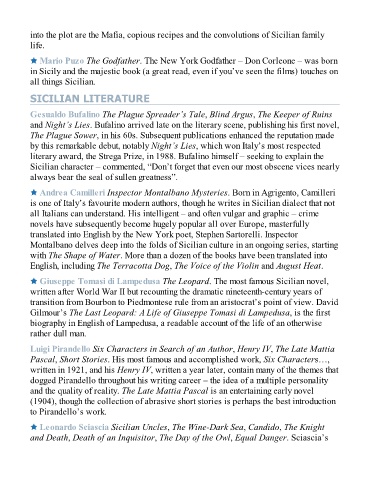Page 593 - The Rough Guide of Sicily
P. 593
into the plot are the Mafia, copious recipes and the convolutions of Sicilian family
life.
Mario Puzo The Godfather. The New York Godfather – Don Corleone – was born
in Sicily and the majestic book (a great read, even if you’ve seen the films) touches on
all things Sicilian.
SICILIAN LITERATURE
Gesualdo Bufalino The Plague Spreader’s Tale, Blind Argus, The Keeper of Ruins
and Night’s Lies. Bufalino arrived late on the literary scene, publishing his first novel,
The Plague Sower, in his 60s. Subsequent publications enhanced the reputation made
by this remarkable debut, notably Night’s Lies, which won Italy’s most respected
literary award, the Strega Prize, in 1988. Bufalino himself – seeking to explain the
Sicilian character – commented, “Don’t forget that even our most obscene vices nearly
always bear the seal of sullen greatness”.
Andrea Camilleri Inspector Montalbano Mysteries. Born in Agrigento, Camilleri
is one of Italy’s favourite modern authors, though he writes in Sicilian dialect that not
all Italians can understand. His intelligent – and often vulgar and graphic – crime
novels have subsequently become hugely popular all over Europe, masterfully
translated into English by the New York poet, Stephen Sartorelli. Inspector
Montalbano delves deep into the folds of Sicilian culture in an ongoing series, starting
with The Shape of Water. More than a dozen of the books have been translated into
English, including The Terracotta Dog, The Voice of the Violin and August Heat.
Giuseppe Tomasi di Lampedusa The Leopard. The most famous Sicilian novel,
written after World War II but recounting the dramatic nineteenth-century years of
transition from Bourbon to Piedmontese rule from an aristocrat’s point of view. David
Gilmour’s The Last Leopard: A Life of Giuseppe Tomasi di Lampedusa, is the first
biography in English of Lampedusa, a readable account of the life of an otherwise
rather dull man.
Luigi Pirandello Six Characters in Search of an Author, Henry IV, The Late Mattia
Pascal, Short Stories. His most famous and accomplished work, Six Characters…,
written in 1921, and his Henry IV, written a year later, contain many of the themes that
dogged Pirandello throughout his writing career – the idea of a multiple personality
and the quality of reality. The Late Mattia Pascal is an entertaining early novel
(1904), though the collection of abrasive short stories is perhaps the best introduction
to Pirandello’s work.
Leonardo Sciascia Sicilian Uncles, The Wine-Dark Sea, Candido, The Knight
and Death, Death of an Inquisitor, The Day of the Owl, Equal Danger. Sciascia’s

